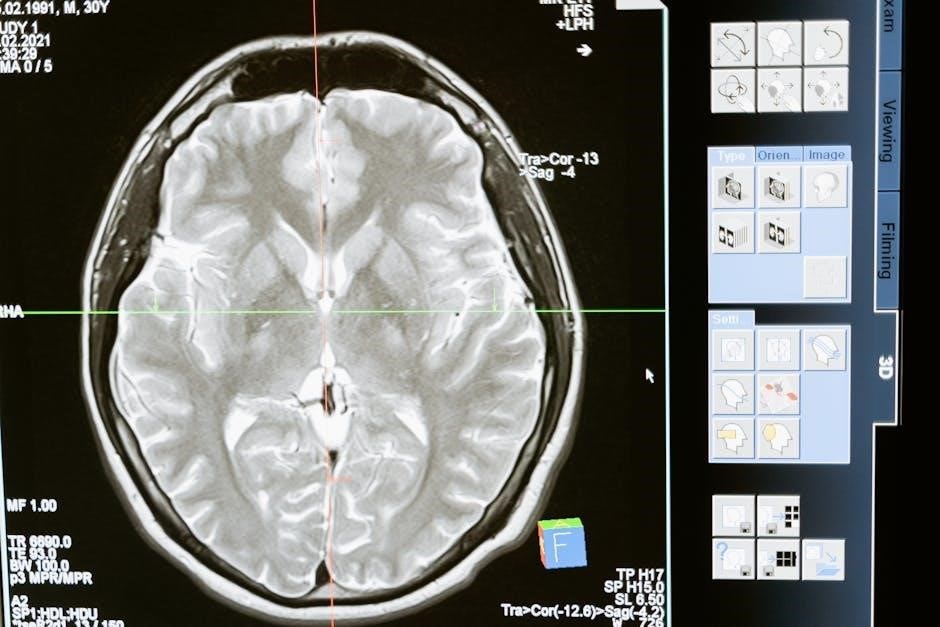
wisc test pdf
The Wechsler Intelligence Scale for Children (WISC) is a standardized test assessing cognitive abilities in children aged 6–16. It evaluates intellectual functioning‚ providing insights into strengths and weaknesses for educational and clinical assessments.
1.1 What is the WISC Test?
The Wechsler Intelligence Scale for Children (WISC) is a standardized psychological assessment designed to measure cognitive abilities in children aged 6 to 16. The fifth edition‚ WISC-V‚ evaluates various intellectual skills through 16 primary and five complementary subtests. It assesses verbal comprehension‚ visual-spatial skills‚ working memory‚ and fluid reasoning. Widely used for clinical assessments‚ educational planning‚ and research‚ the WISC-V provides a comprehensive understanding of a child’s intellectual strengths and challenges‚ aiding in tailored interventions and support strategies.
1.2 Importance of the WISC Test in Assessing Cognitive Abilities
The WISC test is a critical tool for identifying cognitive strengths and challenges in children. It provides insights into intellectual functioning‚ guiding interventions and educational strategies. By assessing verbal comprehension‚ working memory‚ and visual-spatial skills‚ it ensures fair and reliable evaluations. The test’s standardized approach helps clinicians and educators make informed decisions‚ supporting personalized learning plans and therapeutic interventions. Its widespread use underscores its value in understanding and addressing diverse cognitive needs in children.

Structure and Content of the WISC Test
The WISC test comprises primary indexes like Verbal Comprehension and Visual-Spatial Skills‚ along with various subtests. It assesses cognitive abilities in children aged 6–16‚ requiring about 90 minutes to complete.
2.1 Primary Indexes of the WISC-V
The WISC-V assesses cognitive abilities through five primary indexes: Verbal Comprehension‚ Visual-Spatial‚ Fluid Reasoning‚ Working Memory‚ and Processing Speed. These indexes provide a comprehensive understanding of a child’s intellectual strengths and weaknesses. The Verbal Comprehension Index evaluates verbal reasoning and comprehension skills‚ while the Visual-Spatial Index measures spatial reasoning and visual-perceptual skills. Fluid Reasoning assesses logical reasoning and problem-solving abilities‚ Working Memory evaluates attention and short-term memory‚ and Processing Speed measures cognitive efficiency and processing abilities. Together‚ these indexes offer a detailed profile of cognitive functioning in children aged 6–16 years.
2.2 Subtests and Their Significance
The WISC-V consists of 15 subtests‚ 10 primary and 5 complementary‚ each assessing specific cognitive skills. Subtests like Similarities evaluate verbal reasoning‚ while Matrix Reasoning measures fluid intelligence. Block Design assesses spatial visualization‚ and Digit Span evaluates working memory. These subtests provide insights into various cognitive functions‚ enabling a detailed understanding of a child’s intellectual strengths and weaknesses. Their results are crucial for creating tailored educational and intervention strategies to support individual learning needs. Each subtest plays a unique role in the comprehensive assessment of cognitive abilities.
Purpose and Applications of the WISC Test
The WISC test evaluates cognitive abilities in children to guide educational planning‚ diagnose learning disabilities‚ and inform clinical interventions‚ supporting tailored strategies for individual needs and development.
3.1 Clinical Assessment and Diagnosis
The WISC test is widely used in clinical settings to assess cognitive functioning and diagnose learning disabilities‚ intellectual disabilities‚ or other cognitive impairments in children. It provides a comprehensive profile of strengths and weaknesses‚ aiding clinicians in identifying specific challenges and developing targeted interventions. The test’s standardized structure ensures reliability in measuring verbal‚ visual-spatial‚ and working memory abilities‚ making it a valuable tool for accurate diagnoses and tailored clinical support. Its insights are crucial for informing treatment plans and educational strategies.
3.2 Educational Planning and Interventions
The WISC test plays a pivotal role in educational planning by identifying a child’s cognitive strengths and weaknesses. It helps educators develop targeted interventions and individualized learning plans‚ ensuring tailored academic support. By assessing various cognitive domains‚ the test informs strategies to address learning challenges and enhance academic performance. Schools utilize WISC results to design appropriate educational programs‚ fostering a more personalized and effective learning environment for students with diverse needs and abilities.
3.3 Research and Psychological Studies
The WISC test serves as a valuable tool in research and psychological studies‚ enabling investigators to explore cognitive development‚ intellectual disabilities‚ and neuropsychological conditions. Researchers use the test to assess cognitive profiles‚ identify patterns‚ and validate theories related to child development. The WISC-V’s updated structure and enhanced interpretive power make it particularly useful for studying longitudinal changes and cross-cultural differences. It also aids in developing evidence-based interventions and understanding the impact of various factors on cognitive functioning in children and adolescents;

Administration and Scoring of the WISC Test
The WISC test‚ for children aged 6-16‚ takes about 90 minutes‚ comprising 10 primary and 5 complementary subtests. Scoring uses standard scores with confidence intervals‚ requiring trained administrators for reliability and validity.
4.1 Test Administration Process
The WISC test is administered to children aged 6–16‚ requiring approximately 90 minutes to complete. Trained professionals conduct the test‚ ensuring a standardized environment. The process involves 10 primary subtests and 5 complementary ones‚ assessing various cognitive skills. Instructions are clear‚ and responses are recorded meticulously. The administration ensures fairness‚ avoiding bias‚ and accommodates special needs; Strict protocols are followed to maintain reliability and validity‚ ensuring accurate assessment of intellectual functioning for clinical‚ educational‚ and research purposes.
4.2 Scoring Methods and Interpretation
Scoring the WISC involves converting raw subtest scores into standard scores‚ with a mean of 100 and SD of 15. Composite scores are calculated for indexes like Verbal Comprehension and Working Memory. Confidence intervals are provided for accuracy. Interpretation focuses on identifying cognitive strengths and weaknesses‚ guiding interventions. Trained professionals analyze scores to inform clinical diagnoses‚ educational planning‚ and research‚ ensuring a comprehensive understanding of a child’s intellectual abilities.

WISC-IV vs. WISC-V: Key Differences
The WISC-V introduced new subtests and split the Perceptual Reasoning index into Fluid Reasoning and Visual-Spatial skills‚ enhancing interpretive power for clinical insights and assessments.
5.1 Updates in Subtests and Indexes
The WISC-V introduced significant updates‚ splitting the Perceptual Reasoning index into Fluid Reasoning and Visual-Spatial skills. New subtests like Picture Concepts and Figure Weights were added‚ while others‚ such as Word Reasoning‚ were modified. These changes aim to better capture cognitive abilities‚ especially fluid intelligence and visual-spatial skills‚ providing a more nuanced assessment of a child’s intellectual functioning compared to the WISC-IV.
5.2 Enhanced Interpretive Power in WISC-V
The WISC-V offers enhanced interpretive power through improved subtests and scoring methods. It introduces new subtests like Picture Concepts and Figure Weights‚ refining the assessment of fluid intelligence and visual-spatial skills. The updated index structure provides clearer distinctions between cognitive abilities‚ allowing for more precise identification of strengths and weaknesses. Additionally‚ the WISC-V includes enhanced interpretive tools‚ such as composite scores with confidence intervals‚ improving the accuracy of cognitive assessments and supporting more informed clinical and educational decisions.

Criticisms and Limitations of the WISC Test
Criticisms of the WISC test include concerns about cultural bias‚ lengthy administration times‚ and reliance on trained professionals for accurate results. These factors limit accessibility and fairness.
6.1 Cultural Bias and Fairness Concerns
The WISC test has faced criticism for potential cultural bias‚ as its design and norms may not adequately account for diverse backgrounds. Critics argue that certain subtests or items may favor individuals from specific cultural or socioeconomic groups‚ leading to unfair assessments. These concerns highlight the need for cautious interpretation of results‚ especially when evaluating children from varied cultural contexts. Efforts to address these issues have been made in updated versions like the WISC-V‚ but challenges remain.
6.2 Challenges in Administering the Test
Administering the WISC test presents several challenges‚ including the need for highly trained professionals to ensure accurate results; The test’s complexity requires precise timing and scoring‚ which can be time-consuming. Additionally‚ maintaining a standardized environment is crucial‚ yet difficult in diverse settings. Ensuring the test is accessible to children with disabilities or language barriers further complicates administration. These challenges underscore the need for extensive training and resources to effectively use the WISC test.

Sample WISC Test Questions and Format
Sample WISC questions include tasks like Picture Concepts and Vocabulary‚ assessing reasoning and comprehension. The format features multiple-choice and visual puzzles‚ reflecting the test’s cognitive assessment focus.
7.1 Examples of Subtests and Their Structure
The WISC-V includes subtests like Picture Concepts and Vocabulary‚ designed to assess reasoning and verbal comprehension. These tasks often involve identifying relationships or defining words. Other subtests‚ such as Fluid Reasoning‚ use visual puzzles to evaluate problem-solving abilities. Each subtest follows a structured format‚ with clear instructions and timed responses‚ ensuring consistent assessment of cognitive skills in children aged 6–16. The variety of tasks reflects the test’s focus on measuring diverse intellectual abilities.
7.2 Understanding the Test Format
The WISC-V consists of 15 subtests‚ with 10 primary ones contributing to the composite scores. The test format includes a mix of verbal and non-verbal tasks‚ such as vocabulary questions and visual puzzles. Administration typically takes 90 minutes‚ with subtests timed individually. Scores are standardized‚ ensuring comparison to a normative sample. Composite scores are reported with 95% confidence intervals for accuracy. This structured format allows for a comprehensive assessment of cognitive abilities in children aged 6–16‚ providing clear insights into intellectual functioning.

WISC Test Preparation and Practice Resources
Practice tests and study guides‚ including WISC-V PDF materials‚ provide sample questions and tips for effective preparation. These resources help familiarize children with the test format and content.
8.1 Recommended Study Materials
Recommended study materials for the WISC test include official practice PDF guides‚ workbooks‚ and online resources. These materials provide sample questions‚ test formats‚ and strategies to help children prepare effectively. Practice tests mimic the actual WISC-V‚ allowing children to familiarize themselves with the structure and content. Study guides offer detailed explanations of subtests‚ such as Verbal Comprehension and Visual-Spatial Skills‚ to improve understanding and performance. Additionally‚ workbooks focus on specific cognitive areas‚ enabling targeted practice and skill enhancement. These resources are essential for building confidence and readiness.
8.2 Tips for Effective Preparation
Effective preparation for the WISC test involves understanding the test format and practicing specific cognitive skills. Use official WISC-V practice materials to familiarize yourself with subtests like Verbal Comprehension and Visual-Spatial Skills. Focus on improving working memory and processing speed through targeted exercises. Encourage regular practice to build confidence and reduce anxiety. Ensure children understand test instructions and time management. Reviewing sample questions and discussing strategies can enhance performance. A structured and consistent study routine is key to achieving optimal results.